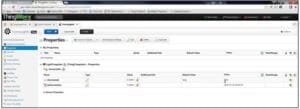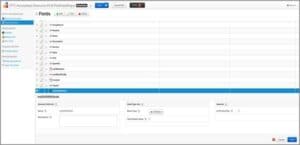IoT enhances law enforcement organizations and practice, and improves the justice system. The technology boosts transparency, distributes critical data, and removes human intervention where it proves unnecessary.
Policing
Law enforcement can be challenging. IoT acts as an instrument of law enforcement which reduces manual labor and subjective decisions through better data, information sharing, and advanced automation. IoT systems shave costs by reducing human labor in certain areas such as certain traffic violations.
IoT aids in creating better solutions to problems by using technology in the place of force; for example, light in-person investigations of suspicious activities can be replaced with remote observation, logged footage of violations, and electronic ticketing. It also reduces corruption by removing human control and opinion for some violations.
This dart planted in a truck gate prevents dangerous car chases. A patrol car launches the tracking dart which pierces the vehicle. Then the main system receives all data needed to locate the vehicle.
Court System
Current court systems utilize traditional technology and resources. They generally do not exploit modern analytics or automation outside of minor legal tasks. IoT brings superior analytics, better evidence, and optimized processes to court systems which accelerate processes, eliminate excessive procedures, manage corruption, reduce costs, and improve satisfaction.
In the criminal court system, this can result in a more effective and fair system. In routine court services, it introduces automation similar to that of common government office services; for example, IoT can automate forming an LLC.
IoT combined with new regulations can remove lawyers from many common legal tasks or reduce the need for their involvement. This reduces costs and accelerates many processes which often require months of traversing legal procedures and bureaucracy.
Consumer Applications
Consumers benefit personally and professionally from the optimization and data analysis of IoT. IoT technology behaves like a team of personal assistants, advisors, and security. It enhances the way we live, work, and play.
Home
IoT takes the place of a full staff −
- Butler − IoT waits for you to return home, and ensures your home remains fully prepared. It monitors your supplies, family, and the state of your home. It takes actions to resolve any issues that appear.
- Chef − An IoT kitchen prepares meals or simply aids you in preparing them.
- Nanny − IoT can somewhat act as a guardian by controlling access, providing supplies, and alerting the proper individuals in an emergency.
- Gardner − The same IoT systems of a farm easily work for home landscaping.
- Repairman − Smart systems perform key maintenance and repairs, and also request them.
- Security Guard − IoT watches over you 24/7. It can observe suspicious individuals miles away, and recognize the potential of minor equipment problems to become disasters well before they do.
This smart, connected stove from Whirlpool allows two different heat settings on the same surface, remote monitoring, and remote control.
Work
A smart office or other workspace combines customization of the work environment with smart tools. IoT learns about you, your job, and the way you work to deliver an optimized environment. This results in practical accommodations like adjusting the room temperature, but also more advanced benefits like modifying your schedule and the tools you use to increase your output and reduce your work time. IoT acts as a manager and consultant capable of seeing what you cannot.
Play
IoT learns as much about you personally as it does professionally. This enables the technology to support leisure −
- Culture and Night Life − IoT can analyze your real-world activities and response to guide you in finding more of the things and places you enjoy such as recommending restaurants and events based on your preferences and experiences.
- Vacations − Planning and saving for vacations proves difficult for some, and many utilize agencies, which can be replaced by IoT.
- Products and Services − IoT offers better analysis of the products you like and need than current analytics based on its deeper access. It integrates with key information like your finances to recommend great solutions.
Thingworx
Thingworx is a platform for the rapid development and deployment of smart, connected devices. Its set of integrated IoT development tools support connectivity, analysis, production, and other aspects of IoT development.
It offers Vuforia for implementing augmented reality development, and Kepware for industrial connectivity. KEPServerEX provides a single point for data distribution, and facilitates interoperability when partnered with a ThingWorx agent.
Components
Thingworx offers several key tools for building applications. These tools include the Composer, the Mashup Builder, storage, a search engine, collaboration, and connectivity. The Composer provides a modeling environment for design testing. The Mashup Builder delivers easy dashboard building through common components (or widgets); for example, buttons, lists, wikis, gauges, and etc.
Thingworx uses a search engine known as SQUEAL, meaning Search, Query, and Analysis. Users employ SQUEAL in analyzing and filtering data, and searching records.
Interface
The ThingWorx platform uses certain terms you must familiarize yourself with. In the main screen’s top menu, you search for entities or create them. “Entity” refers to something created in ThingWorx. You can also import/export files and perform various operations on them.
In the left menu, you find entity groups, which are used to produce models and visualize data; and manage storage, collaboration, security, and the system.

interface
When you select the Modeling category in the menu, you begin the process by creating an entity. The entity can be any physical device or software element, and it produces an event on changes to its property values; for example, a sensor detects a temperature change. You can set events to trigger actions through a subscription which makes decisions based on device changes.
Data Shapes consist of one or more fields. They describe the data structure of custom events, infotables, streams, and datatables. Data shapes are considered entities.

datashapes_fields
Thing Templates and Thing Shapes allow developers to avoid repeating device property definitions in large IoT systems. Developers create Thing Templates to allow new devices to inherit properties. They use Thing Shapes to define Templates, properties, or execute services.
Note a Thing only inherits properties, services, events, and other qualities from a single template, however, Things and templates can inherit properties from multiple Thing Shapes.
Development
ThingWorx actually requires very little programming. Users connect devices, establish a data source, establish device behaviors, and build an interface without any coding. It also offers scalability appropriate for both hobbyist projects and industrial applications.

0 Comments